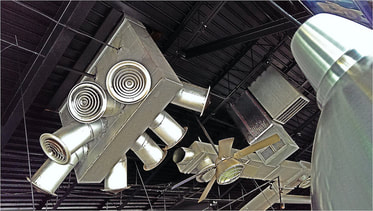Cannabis Cultivation HVAC
Cannabis Facility HVAC
The foundation of a successful cannabis cultivation facility is well designed, reliable climate controls. Plants "transpire" (breathe/sweat) water into the air in significant amounts, yet room humidity must be kept between 50-70% in order to keep them growing at their fastest healthiest rate. It seems unbelievable, but the plants under a single grow light can release up to 4 gallons a day of water into the air! Without powerful dehumidification equipment, the room will quickly rise to 100% relative humidity (RH), causing a rapid decline in plant conditions and a likely mold outbreak, both of which are immediate risks to the crop.
Similarly, the heat produced by grow lights is like having a bunch of high-wattage space heaters in the room. Without powerful and consistent air conditioning equipment, the heat will rise to levels that will quickly harm the plants.
It's easy to think the solution is simply to buy off-the-shelf air conditioners and dehumidifiers to maintain grow room setpoints, but unfortunately, there are complications to that approach. Equipment that is not purpose built or powerful enough, or is not designed properly, will not maintain temperature and humidity setpoints well enough. There will be peaks and valleys in the readings throughout every 24-hour period, leading to crop quality problems and mold outbreaks. Powdery mildew for example--one of the biggest pestilence problems in indoor facilities--happens to thrive in the swings that occur between those peaks and valleys. That means growers need to invest in equipment that will keep conditions as stable as possible.
The Importance of Vapor Pressure Deficit
The other critical reason to avoid peaks and valleys in your setpoints is to maintain optimal plant growth rates. There's this metric called Vapor Pressure Deficit (VPD) that's a measure of how efficiently the plants are transpiring through their stomata (the "vent" holes on the undersides of the leaves). When they transpire efficiently, they grow fast and unabated, which = higher yields. If the temperature and humidity are not stable, the VPD will swing in and out of range, which reduces the amount of time in each day that the plants are growing optimally.
In commercial growing, crops are simply too valuable to risk by cutting corners on climate controls. Maintaining temp/RH setpoints and VPD has such a direct effect on yields, quality and value that you're setting yourself up for failure, or at least mediocrity, unless you are taking these factors seriously in your budgeting and facility design.
At least a dozen companies offer cannabis HVAC systems that they claim can do a great job of handling indoor cannabis HVAC requirements, but how do you know which ones perform best, and how to compare quotes? It's not simple! Some companies handle ancillary climate control functions, like air purification, Co2 inject and safety purges, where others just handle temperature and humidity maintenance. Some have variable speed, more efficient compressors while some have less efficient on/off compressors. There are lots of variations once you look under the hood, and these kinds of things matter once you are operational.
Need help figuring out your loads and water usage rates for HVAC system sizing, or need further education in cannabis HVAC?
Further Reading:
Budgeting for HVAC and Climate Controls
Cannabis HVAC Consulting Services - Meet Our Expert
Budgeting for HVAC and Climate Controls
Cannabis HVAC Consulting Services - Meet Our Expert
